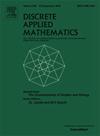稀疏图的富邻边着色
IF 1
3区 数学
Q3 MATHEMATICS, APPLIED
引用次数: 0
摘要
设φ为图g的适当的边着色,如果与e相邻的边得到不同的颜色,则边e是丰富的。特别是,垂边和孤立边都是丰富的。Petruševski和Škrekovski(2024)引入了富邻边着色的概念,作为对强边着色的弱化。如果每条非孤立边与至少一条富边相邻,则适当的k-边着色φ是一个富邻居k-着色。Petruševski和Škrekovski(2024)推测除了K4外,每个连通的次立方图都有一个富邻5着色。我们证明了如果G是次三次图,则•[(1)]如果mad(G)<3613,则G具有富邻6着色;•[(2)]若G无爪,则G具有富邻6着色。本文章由计算机程序翻译,如有差异,请以英文原文为准。
On the rich-neighbor edge-coloring of sparse graphs
Let be a proper edge-coloring of a graph . An edge is rich if the edges adjacent to receive distinct colors. In particular, a pendant edge and an isolated edge are both rich. Petruševski and Škrekovski (2024) introduced the concept of rich-neighbor edge-coloring as a weakening of strong edge-coloring. A proper -edge-coloring is a rich-neighbor -coloring if each non-isolated edge is adjacent to at least one rich edge. Petruševski and Škrekovski (2024) conjectured that every connected subcubic graph admits a rich-neighbor 5-coloring except for . We show that if is a subcubic graph, then
- •[(1)] if , then has a rich-neighbor 6-coloring; and
- •[(2)] if is claw-free, then has a rich-neighbor 6-coloring.
求助全文
通过发布文献求助,成功后即可免费获取论文全文。
去求助
来源期刊

Discrete Applied Mathematics
数学-应用数学
CiteScore
2.30
自引率
9.10%
发文量
422
审稿时长
4.5 months
期刊介绍:
The aim of Discrete Applied Mathematics is to bring together research papers in different areas of algorithmic and applicable discrete mathematics as well as applications of combinatorial mathematics to informatics and various areas of science and technology. Contributions presented to the journal can be research papers, short notes, surveys, and possibly research problems. The "Communications" section will be devoted to the fastest possible publication of recent research results that are checked and recommended for publication by a member of the Editorial Board. The journal will also publish a limited number of book announcements as well as proceedings of conferences. These proceedings will be fully refereed and adhere to the normal standards of the journal.
Potential authors are advised to view the journal and the open calls-for-papers of special issues before submitting their manuscripts. Only high-quality, original work that is within the scope of the journal or the targeted special issue will be considered.
 求助内容:
求助内容: 应助结果提醒方式:
应助结果提醒方式:


